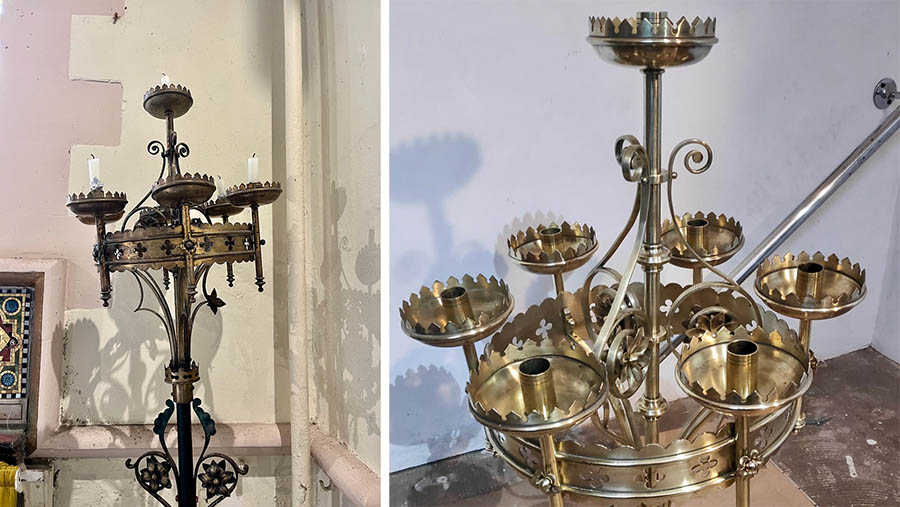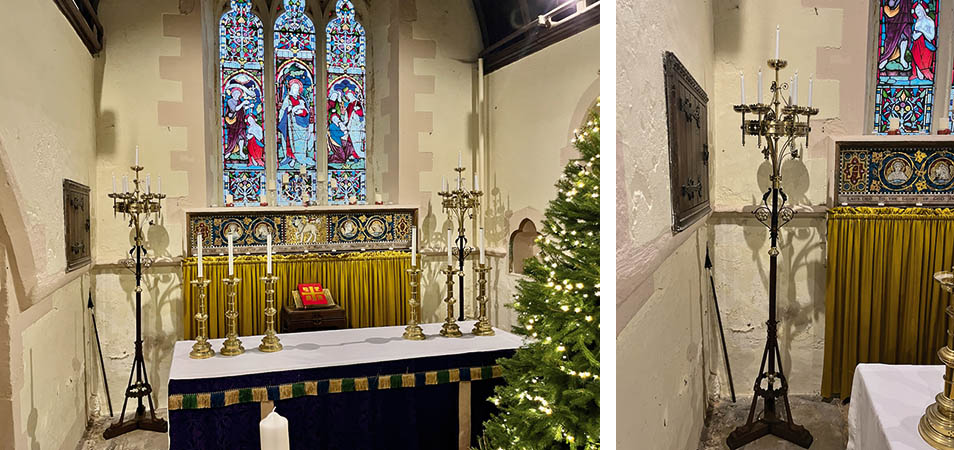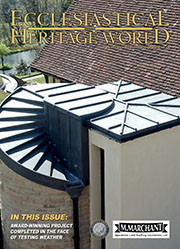Careful conservation allows candelabra to shine again
 The candelabra top before conservation (left) and the brass candle ring after completionThe Church of St Michael and All Angels is in Skelbrooke, a small village to the north of Doncaster, beside the A1 trunk road. The church is listed Grade II by Historic England, with a chantry chapel recorded on the church site as early as 1338.
The candelabra top before conservation (left) and the brass candle ring after completionThe Church of St Michael and All Angels is in Skelbrooke, a small village to the north of Doncaster, beside the A1 trunk road. The church is listed Grade II by Historic England, with a chantry chapel recorded on the church site as early as 1338.
Some elements of a medieval church survive, including some stone arches between the chancel and chantry chapel. They were bricked up during the reformation in 1549 and are some of the few early features to survive a serious fire that destroyed much of the church building in 1870.
The Neville family, owners of the estate at the time, rebuilt the church in 1872, including the chantry chapel. Leicester architect Joseph Goddard was appointed and used much of the original stone. It was built by local contractors Shillito and Morgan of nearby Campsall village. The only part not to be rebuilt was the tower, which was increased in height by six feet.
The church was given an attractive Victorian interior, including a mosaic reredos and high-quality tiles laid on the floor of the chancel and the chapel. A number of windows were made: by Kempe for the south side of the chancel and nave; the east window and that in the north wall of the nave by Heaton, Butler and Bayne; and a slightly later west window by Lowndes and Drury.
On each side of the main altar is a large iron and brass candelabra that may have come from Selby Abbey – which was badly damaged by a fire in 1906 – and were donated to the church about 10 years ago by a local villager. The Victorian candelabra have many details that suggest they may have been made at Francis Skidmore’s workshops in Coventry, as he produced a lot of decorative metalwork for churches in the later 19th century.
The candelabra are over two metres high, with tubular iron uprights supported on three iron feet with a decorative circular collar at low level. The feet are fixed to a three-armed oak cross that forms the base. The ironwork is painted in dark red with decorative elements picked out in green, red and yellow. At the base of each tube is a decorative, polished brass finial.
At the centre of each candelabra is some painted decorative scrollwork with a pair of polished brass flowers fixed through the centre of each scroll, connected to the top of the tubular upright by a polished brass piece. Mounted on top of the scrollwork is a large, polished brass candle holder in the form of a ring of brass supporting six candle sconces. From the centre rises one further candle sconce. This brass ring is supported off a central brass piece, connected by large brass scrolls.
 The candelabra in situ after conservationThe Historic Metalwork Conservation Company was approached by the churchwarden of St Michael and All Angels to provide a proposal and cost to clean and repair the pair of candelabra. That was forwarded to the Diocese of Sheffield Diocesan Advisory Committee for approval. Peter Meehan ACR was asked to undertake the works in the autumn of 2023.
The candelabra in situ after conservationThe Historic Metalwork Conservation Company was approached by the churchwarden of St Michael and All Angels to provide a proposal and cost to clean and repair the pair of candelabra. That was forwarded to the Diocese of Sheffield Diocesan Advisory Committee for approval. Peter Meehan ACR was asked to undertake the works in the autumn of 2023.
The candelabra were found to be in a poor general condition. The various components were loose fitting and there was evidence of previous repairs to the brass candlestick rings. The brasswork had some evidence of old lacquer that had degraded and most of the brass was heavily oxidised and tarnished. The painted ironwork, however, was in a good overall condition.
The candelabra were partially dismantled and transferred to a workshop for conservation treatment. The brass candle rings were completely dismantled to allow for thorough cleaning. Old lacquer, polish residues, oxidation and tarnish layers were removed using a combination of techniques. A handheld steam cleaner was used to remove old patches of lacquer and polish residues.
The brass was then cleaned and polished using Duraglit Brasso wadding and Autosol metal polish applied on a soft cloth. There were a small number of missing brass fixings and decorative flowers, which were replaced with replica pieces in brass.
The painted iron stand and scrollwork pieces were carefully cleaned using very fine 3M Scotchbrite pads to remove dirt and minor paint oxidation layers. The paint layers were consolidated using a 5% solution of Paraloid B67 – an acrylic resin. The lower decorative brass pieces were protected with a coating of Incralac brass lacquer. It was decided to leave the candle rings unlacquered as they were likely to be damaged, resulting in unsightly patchy oxidation of the brass.
The oak feet were cleaned using fine 3M Scotchbrite pads to remove dirt layers before they were protected with a coating of a linseed oil/beeswax mixture.
The candelabra were returned to the church of St Michael and All Angels in time for their Christmas Carol Concert. They were re-assembled in the church and placed back on each side of the altar. In order to prevent the buildup of wax on the conserved candelabra, the churchwarden decided to fit remote-controlled electric candles. As the candelabra are so tall it also reduced the risk of accidental damage in the future while trying to remove and fit traditional wax candles.
• For further information visit www.hm-cc.uk













